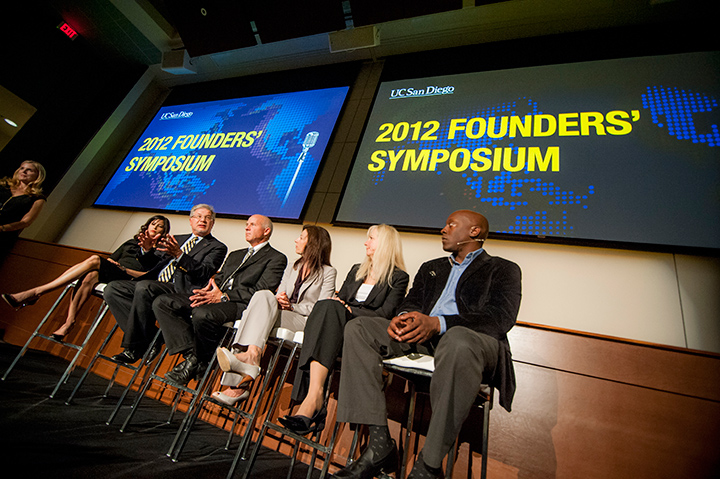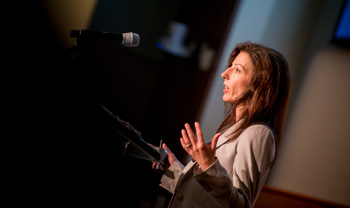Study Finds X’s Community Notes Provides Accurate Responses to Vaccine Misinformation
Health & Behavior
By:
Published Date
By:
Share This:

Photos by Erik Jepsen/UC San Diego Publications
It’s not often you can go to an event and be asked to leave your cell phone on to share thoughts via social media. At the Founders’ Symposium held Friday, however, that was exactly the case. Event moderator and UC San Diego alumna Lauren Reynolds ’94 encouraged the audience to interact on Twitter (#UCSDFounders) during the event.
As part of the annual Founders’ Day celebration, the Founders’ Symposium featured six innovative faculty members offering brief talks about world-changing research happening on our campus. Speaking to a full house, these exciting speakers from a variety of disciplines underscored the academic excellence of UC San Diego.

Chancellor Pradeep K. Khosla introduced the program by noting, “This evening is about the core of UC San Diego—our intellectual brain trust.”
Executive Vice Chancellor of Academic Affairs Suresh Subramani added, “Tonight is about what our faculty do and how they inspire us.”
In the intimate setting of the new J.R. Beyster Auditorium in the Rady School of Management’s Fargo Hall, the 10-minute discussions shared relevant research and topical issues, showcasing work that has real impacts on everyday lives. The lively Q&A session at the end of the program featured additional insights into each speaker’s work.
Here was an early tweet from an audience member:

Following are brief highlights from the evening:
Director, Center of Excellence in Nanomedicine
In her “Art of Falling Apart” presentation, Adah Almutairi shared research about materials that fall apart on demand for drug delivery and other uses, such as in response to inflammatory conditions associated with cancer and heart disease. Her work also involves near infrared, a wavelength of light that that physicians can use as a tool to see inside the body. A riveting portion of the talk—at least for many women in the room—is the project she is focused on now using gold nanoparticles to melt fat for cosmetic procedures and to tighten skin—and Almutairi says it’s working.
An enthusiastic tweet followed her talk:

Dean, Division of Arts & Humanities
Explaining he is bilingual—“I speak both English and Ph.D.” —Dean Seth Lerer discussed the transition of print to digital literacy. The academic and author told the audience that the experience of reading a book is absorptive; reading it on screen, the experience is theatrical. Later in the Q&A, he said, “Digital places us at an intellectual disadvantage. We confuse digital literacy with technology.”
Earlier, Lerer had said he hoped people would come to listen to and learn that digital technologies may supplement but never truly replace the printed or handwritten text; and that the experience of teaching and reading can be engaging, funny, moving and life affirming. He offered all that and more—including quips like this that prompted laughter from the crowd:

Co-Director, Food & Fuel for the 21st Century
Director, San Diego Center for Algae Biotechnology
“Food and Fuel for the 21st Century” was the original title of Stephen Mayfield’s talk, but on Friday night the entrepreneurial professor (he is a co-founder of San Diego-based Sapphire Energy) added, “How Rainbow Algae Can Change the World.” Mayfield shared information about the relation between world population and energy production, noting how the little things we do can ultimately change the world. He then turned the discussion to his quest to find a cheaper and more efficient way to produce medicines. His research with rainbow algae has attracted funding from the Bill & Melinda Gates Foundation. Currently, he is working on three different and exciting algae solutions: a treatment for bacterial diarrhea that will be introduced soon; in the near future, a malaria vaccine and magic bullets for cancer treatments.

Amanda Datnow
Chair, Department of Education Studies
Amanda Datnow expressed an urgency to create high quality K-12 teachers so they can help 21st century learners tackle problems of global importance. “These kids are our future,” she emphasized. Teachers need to become classroom researchers and expert collaborators, and use technology as a tool. She shared that one of UC San Diego’s Education Studies most successful initiatives is Partners at Learning (PAL), a service-learning program in which undergraduate students provide tutoring and mentoring services in San Diego schools. PAL is the largest service program on campus with 500 volunteers. Partner schools in our region actively seek out UC San Diego teacher graduates, including the Preuss School, a charter school on our campus that embraces education innovation with 33 UCSD graduates as teachers.
Chair, Department of Economics
Macroeconomist Valerie Ramey spoke to an audience eager to learn more about the “fiscal cliff,” the popular term used to describe the fiscal crisis the U.S. government could face at the end of 2012 when the terms of the Budget Control Act of 2011 are scheduled to go into effect if Congress does not agree on a budget compromise. Is that going to throw us into recession? It isn’t a simple answer, according to Ramey. Easier to explain is her comment that we need new ideas for stimulating the economy. She added in the Q&A session that healthcare reform is now eating into the U.S. economy.
Ramey served on a special panel of the Congressional Budget Office—and the office changed its forecasts based in part on her work. When asked by an audience member, “What strategies will reduce unemployment,” she said, “I don’t know yet.” But when Ramey is ready to talk, our government is sure to listen.

Todd P. Coleman
Professor, Department of Bioengineering
The evening’s presentations ended with Todd Coleman’s discussion of invisible technology that will allow people to basically put a computer in a temporary tattoo. This new wireless tattoo electronics technology features a wireless antenna and can even include a small battery, with a sensor to transmit vital data that is virtually invisible to the observer or user. In his work with premature babies, Coleman said a key research focus is on newborn brains, including the issues of strokes and seizures. Used in hospitals, wireless tattoo electronics offer an added benefit–mothers have an opportunity for skin-to-skin contact with their premature baby, without bulky monitors and wires. The technology can also be used at home to monitor the newborn. Future applications could include brain to computer interfaces. Coleman is excited about turning science fiction into reality!
By the audience reaction, the retooled Founders’ Symposium format was a success. This tweet summed it up well:

Share This:
Keep up with all the latest from UC San Diego. Subscribe to the newsletter today.